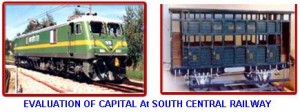OBJECTIVES OF THE STUDY:
- To study the relevance of capital budgeting in evaluating the project in a government organization.
- To study the technique of capital budgeting for decision- making.
- To understand an item wise study of the organization financial performance.
METHODOLOGY:
The information for this report has been collected through the Primary and secondary sources.
Primary sources:
– The data is collected through the observation in the organization and interview with officials.
– By asking question with the accounts and other persons in the financial department.(oral questioning)
Secondary sources:
These secondary data is existing data which is already been collected by Others, for that the sources are financial journals, annual reports of the SOUTH CENTRAL RAILWAY, RAILWAY website, and other Publications of RAILWAY
 LIMITATION OF THE STUDY
LIMITATION OF THE STUDY
– Lack of time is another limiting factor, ie., the schedule period of 6 weeks are not sufficient to make the study independently regarding Capital Budgeting in S. C. RAILWAYS
– The busy schedule of the officials in the S.C.RAILWAYS is another limiting factor.
– Due to the busy schedule officials restricted me to collect the complete information about organization.
– Non-availability of confidential financial data.
– The study is conducted in a short period, which was not detailed in all aspects.
NEED FOR THE STUDY
– The EVALUATION OF CAPITAL At SOUTH CENTRAL RAILWAY MBA Finance Project study is undertaken to analyze and understand the Capital Budgeting process in South Central Railway, which gives main exposure to practical implication of theory knowledge.
– To know about the organization’s operation of using various Capital budgeting techniques.
– To know how the organization gets funds from various resources.
FINDINGS
– It is estimated that a capital requirements of 2 lakhs of crores is required to complete the thousands of projects already included in existing projects.
– Actual realization of rate of return projected in at the time of project appraisal will depend on timely completion of project without any time over run and cost overrun.
– The financing of Railways projects is organized at Indian Railway level unlike Public Sector Units /Private companies were in Bank Finance involved.
CONCLUSION
– The NPV method followed on Railways is satisfactory.
– The IRR method worked to evaluate the Railway projects is based on Discounted Cash Flow Technique.
– In this method, the unit Cost Worked out by traffic costing department of Railway is adopted. The unit costs are updated continuously i.e., every year after closure of Financial Accounts of Railways.
– In the two projects selected for studying the methods of financial evaluation of Railways projects it is seen the rate of return is estimated 17% to 22%.
Download Evaluation of Capital at South Central Railway MBA Finance Final Year Project Case Study.
